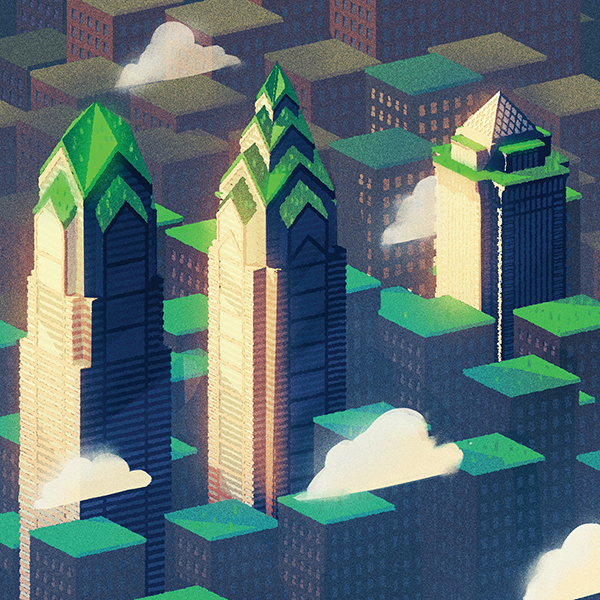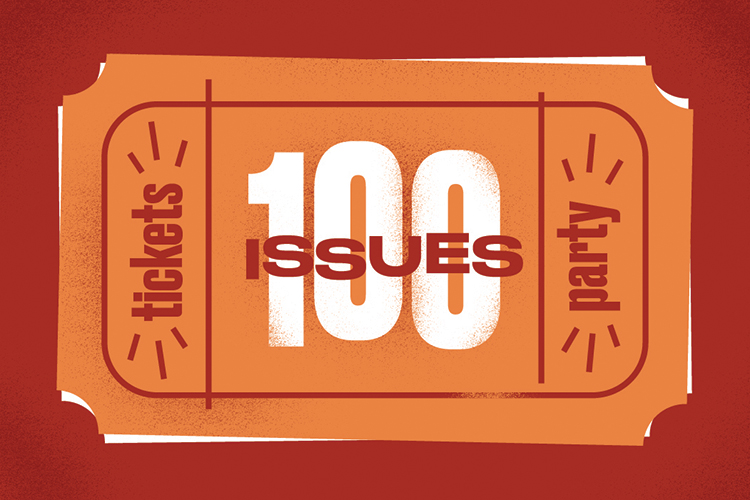Illustration by Corey Brickley
Goodbye to All That
interview by Heather Shayne Blakeslee
According to landscape planners Claudia West and Thomas Rainer, we should all be saying “goodbye to the real estate industry, good taste, designers’ egos, eco-evangelism and the horticulture industry.” Their book, “Planting in a Post-Wild World,” is a joyous ode to the future of landscape and garden design. Grid spoke with Claudia West.
You mention in the book that you were in East Germany in the ’80s. You say it was a “gray and polluted world, and the rivers of my childhood had a different color every week, depending on the color of dye used in the textile factories.”
CW: [As the] East German regime was crumbling in the late ’80s and then finally in ’89, ’90 with the fall of the wall, the entire economy and society changed, and the huge cleanup effort started in that East German landscape, which resulted in massive tree planting—huge reclamation projects. I think the only thing that was able to heal this landscape was brought back—and that’s plants. That changed my entire worldview really dramatically. There’s nothing more hopeful than seeing the craters of soft coal mining that eradicated an entire landscape turn into clean and clear lakes… and hearing the European wolf there at night. For me, this is the most powerful and positive message. It’s never too late. Nature is incredibly resilient.
When the colonists came to North America, what kind of a landscape would they have seen?
CW: I’m not an expert on that, but I think the first settlers here completely misunderstood this landscape. They saw it as wilderness, they saw it as threatening, because they didn’t understand it. They didn’t know that before they set foot on that land, there were people here who were managing this landscape in a very sophisticated way. [The native peoples] founded huge gardens, they managed our woodlands and forests for nuts, they managed grasslands for better hunting grounds. [They had] a very intimate relationship to the land and created incredible, biodiverse, functioning, sustainable landscapes. The land loves people back. We are just learning how to understand that and how to redesign and develop our own relationship with that land now. It’s a really fascinating process.
On the issue of wildness, what do you mean when you talk about the “legibility” of a landscape?
CW: “Legibility” is of course a term that comes from the world of landscape architecture, and it basically means that a landscape is easy to navigate. It’s easy to understand, it is designed, it resonates with people, it has emotional content—either dramatic color or some kind of feature that inherently feels comfortable to us people based on this evolutionary connection with land, these archetypal landscapes that we gravitate toward. So, “legibility” means that it’s not overpowering, not a wildness, but the eye travels clear through it, and people associate with it and feel comfortable with the landscape. In the forest, it could mean walking through the woods and there are brambles everywhere and thicket, and you almost feel intimidated by it and claustrophobic, you can’t see far—that is not legible, that’s the opposite. But what if you have your canopy trees, they’re spaced farther apart, and maybe instead of this big thick shrub layer you only have a few shrubs in there, maybe in clusters, but the rest is fairly open, and you can see, it feels comfortable, you have this beautiful, lush mix of herbaceous species covering the forest floor—that’s legibility, that’s what feels good to people.
Can you talk a little about “archetypal landscapes” that we are programmed to be drawn to by evolution?
CW: When you look to this science called ecopsychology that analyzes our human connection with landscapes, you will find out that there are certain archetypal or ideal landscapes that resonate extremely deeply within us—and that goes across cultures. These archetypal landscapes that feel inherently comfortable to us… used to support us in the past—meaning, providing secure shelter and secure and consistent sources of food: pure forests, woodlands, savannah-type landscapes and grassland-type landscapes. This is an incredible opportunity for us to reconnect with nature by using these archetypal landscapes as design inspiration.
You write that we should be envisioning “meadows growing on skyscrapers, elevated roads covered with connected forests, and vast constructed wetlands that purify our drinking water.”
CW: I think that our cities are the next new frontier. They are the places where we have a nature deficit—where many people live—and people need nature. Greenness: the most powerful color on earth. It’s not the flowers, it’s the color green that people connect to, and we need this green around us every day for our own psychological and physical health. We desperately need more natural landscapes that keep us healthy and at the same time soak up the rain and provide habitat in cities. Quite honestly, we’ve paved over the planet, and we need to bring nature back into our cities, because that’s probably where a huge chunk of nature will live in the future. All of these “wild” places outside of cities? They’re gone.
One of the pictures in the book shows a green roof on top of an Exxon gas station in the middle of a city. You could write a book just on the ironies and possibilities of that one image. Why did you include it?
CW: Maybe it’s because it shows that the opportunities are everywhere now. Like we said, it’s the meadows on top of skyscrapers or the one rain garden surrounded by an acre of paved garage or the parking lot of a big mall. We need to think outside the box and use the spaces we have available to bring as much green and functioning nature back into our cities, right on top of buildings, wherever we have an opportunity. And it is possible. This is the future of what cities will have to look like if we, as a species, want to survive.
One of the sentences that stood out to me was, “The question is not what grew there in the past but what will grow there in the future.”
CW: There’s really no going back. Even what grew there in the past, considering the new environmental conditions that we have created here on the planet, what grew in the past may not be the best solution anymore. I think that the level of environmental disturbance—pollution, climate change—and how people now use this land requires different planting scenarios so they can coexist with us in the future.
Let’s talk about home gardening. Mulch is ubiquitous, but it’s not really necessary.
CW: Right. Plants are really the best mulch on earth. Don’t get me wrong, we’re not against using mulch at all, but mulch should only be temporary in your garden, to fill gaps between plants until they are more established… [to] suppress maybe an early wave of sun-loving weed species. But then we really want plants to grow in as they can and cover that soil on their own. So really the best and most sustainable way of gardening is letting plants be the mulch that they’re designed to be. This is how nature works, this is how plants want to grow—that’s how they evolved to grow—and it definitely works way better.
At one point you mention that “a gardener should act less like a prison guard and more like a referee.” I love that.
CW: Yes, exactly—asking people to relax and enjoy this process of gardening, instead of putting plants in solitary confinement and saying, “This is the spot that you will grow forever from now on.” Most of the really showy species people buy in garden centers don’t get any older than four or five years… by nature they’re not designed to get any older. So if they can’t reseed in your garden, you will lose them, and you wil
l always have to replant more and more, and that is not sustainable, because every plant that comes from a nursery has an enormous carbon footprint—potted in peat moss from Siberia or Northern Canada, and then shipped from Las Vegas. The more sustainable way of gardening is letting what you have in your garden reseed and then being that referee that kind of massages where the seedlings come up and designs with that, editing to still make it look beautiful. Allowing that wildness to happen in the garden is an incredibly enjoyable way of reconnecting with nature, doing what people have done for thousands of years.
What other advice would you give to home gardeners?
CW: It’s very simple, I usually say: Plant more of the right kinds of plants. Replace the mulch with more ecological plants—meaning native and beneficial exotic species—that will dramatically help in creating better cities.
Plant more plants!
Claudia West is a consultant for North Creek Nurseries and is co-author of the book “Planting in a Post-Wild World: Designing Plant Communities for Resilient Landscapes.”





I’d agree with just about everything in this interview. As a nursery owner, I’d even agree with the general notion that "every plant that comes from a nursery has a(n) …carbon footprint." However, many nurseries make their own potting soils using ingredients besides peat. Perhaps it’s this articles American-centric perspective, but indeed, not all peat is harvested from northern Canada; there is peat harvested within 50 kms from me in Nova Scotia and, by the way, my plants never make it to Nevada. Many nurseries are truely local in their operation, propogating and selling to the communities around them. Do they have starter plants shipped into them? For sure, but that’s an issue of concentration in the industry supported by big industry and a consuming public who value cheap plants over local businesses. The larger issue, and one I admit to struggling with is the enormous amount of plastic in current-day horticulture. I’d very much appreciate innovation in the area of biodegradable containers. Now that’s something to work on!